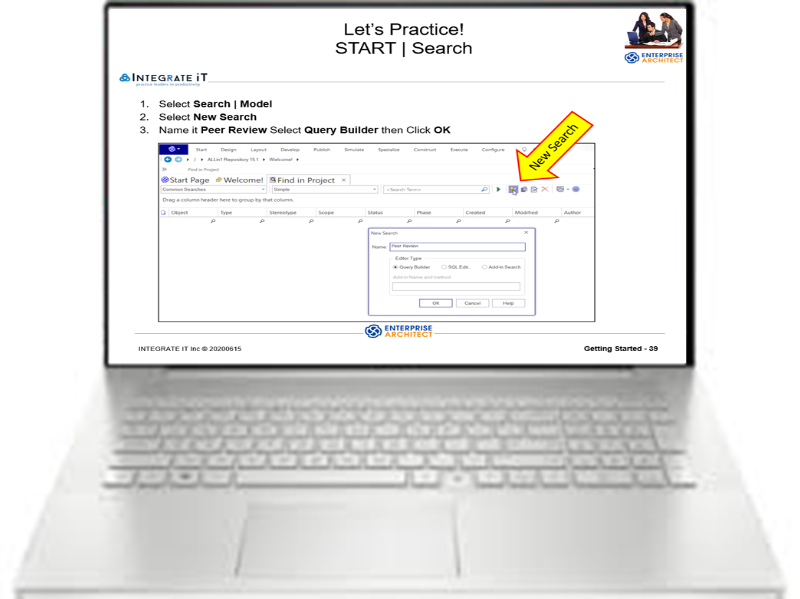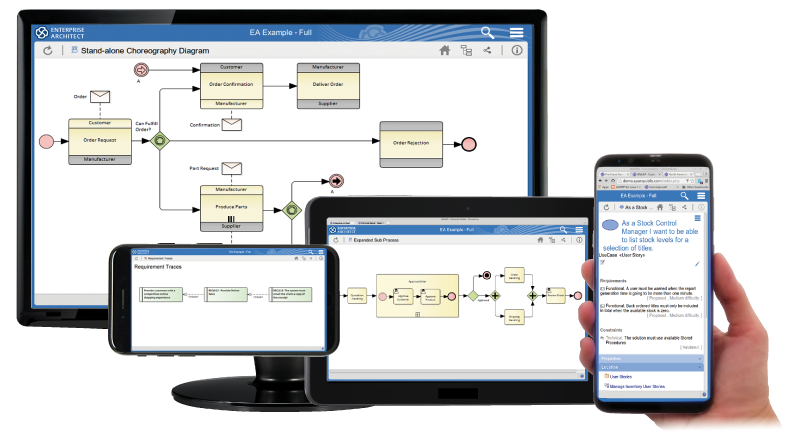FEAF Architecture Development for Teams
Delivered by TOGAF©, ArchiMate©, Sparx Systems Certified Consultants
Duration: 3 days – Virtual Learning and mentorship led by Practice Leader and Sparx SME
The purpose of an Enterprise Architecture capability is to perform architecture planning and deliver outcomes to enable value and reduce risk my managing stakeholders, capabilities, processes, and technology artifacts across an enterprise. Key artifacts need to be stored in an architecture repository to simplify and enable effective reporting. Architecture models are used to evaluate and plan target architectures compared to a baseline model to determine impacts over time.
This focused hands-on course reveals the importance of reusing FEAF, TOGAF©, ArchiMate, knowledge domain methods and techniques. Work directly with an experienced practice leader and improve your skills using Sparx Enterprise Architect using the proven FEAF & TOGAF© Architecture Development Method. This course contains 80% hands-on and 20% lecture.
Upon course completion you will be able to apply your skills using your next project and become confident using Sparx Enterprise Architect, an industry leading tool for over 20 years now with a user community of one million.
This comprehensive mission tested course pragmatically reveals how to perform FEAF Architecture Development using ArchiMate© for all levels of individuals who need to learn and practice their skills to deliver artifacts using Enterprise Architect across the Architecture Layer. This course follows the FEAF V2 Consolidated Reference Model and views as follows:
- Become confident using your hands-on skills when using Sparx Enterprise Architect
- Strategic Layer - Model Architecture Vision to align Leadership and Deployment outcomes using the Performance Reference Model (PRM)
- Business Layer – Model the Capability & Process architectures using the Business Reference Model (BRM)
- Application Layer – Model Application Portfolio Management using the Application Reference Model (ARM)
- Data Layer - Model Data Architectures using the Data Reference Model (DRM)
- Infrastructure Layer – Model Networks, Clients, & Servers using the Infrastructure Reference Model (IRM)
- Security Layer – Model NIST Risk Management Framework using the Security Reference Model (SRM)
- Practice using a FEA Version 2 configured and tailorable EA Architecture Repository
Our expert instructors work closely with every student to personally ensure they fully grasp every lesson plan during the numerous Let’s Practice hands-on workshops sessions and long after the course to mentor and ensure that your TOGAF® or Archimate® Certification is achieved. Learn by doing and build your Enterprise Architecture practice.

- Sparx Systems Enterprise Architect Certification
- Certificate of Education Credits
Anyone who needs to comprehend the TOGAF® Architecture Development Method (ADM) and learn by doing
- To learn the TOGAF® ADM by doing hands-on practice and pass the exam and to become TOGAF® Certified
- To become proficient to perform ArchiMate® modeling and learning the notation to become Archimate® Certified
- To evaluate Sparx Systems Enterprise Architect for Architecture Development prior to full adoption
- Anyone who needs to find a rewarding and highly interesting career for the digital future
What students will learn is how to apply lean standards using the Sparx Systems Enterprise Architect architecture repository that deliver value and reduce risk by modeling before building. Experience insights and techniques with a watchful eye of a highly skilled Archimate certified TOGAF® Architect, who is directly involved in many successful consulting engagements using lean standards, tools, and techniques. Build your team, tool skills, and techniques. You’ll experience hands-on learning doing one iteration of the FEAF Architecture Development Method
Getting Started using Enterprise Architect
- Course Introduction
- How to use your Digital Course Notes – Let’s Practice!
- The Benefits of using Architecture Repository? – Let’s Practice!
- Using the Enterprise Architect Ribbon – Let’s Practice!
- Architecture Artifacts (Packages, Diagrams, & Elements) – Let’s Practice!
- The Benefits of Reuse?
- START – Search the Model – Let’s Practice!
- DESIGN – Add Package, Add Diagram, Add Toolbox
- LAYOUT - Themes and Appearance – Let’s Practice!
- DEVELOP – Database Modeling
- SIMULATE – Business Process Simulation
- EXECUTE - Code Execution
- CONSTRUCT – Kanban
- SPECIALIZE – Model Technologies, MS Office Integration
- PUBLISH – Generate Word Documents
- SETTINGS – Security, Groups, Permissions
- Enterprise Architecture – Deployment Considerations
Strategy & Motivation
- Leveraging Business Architecture best practices
- What does success look like?
- Establish the architecture project – Let’s Practice!
- Stakeholder Analysis - Let’s Practice!
- Confirm drivers and goals – Let’s Practice!
- In Scope Capabilities
- Confirm Business Principles – Let’s Practice!
- Define the Architecture Vision
- Define the target business case
- Identify transformation risks and mitigation strategy
- Establish the transformation Communication Plan!
- Generate the Transformation Project Vision Document – Let’s Practice!
Business Layer
- Business Architecture best practices
- Leveraging Reuse Knowledge & Patterns
- Strategy and Motivation
- Stakeholder Analysis - – Let’s Practice!
- Business Scenario
- In Scope Capabilities – Let’s Practice!
- Business Goals – Let’s Practice!
- Business Drivers – Let’s Practice!
- Business Outcomes – Let’s Practice!
- Value Stream – Let’s Practice!
- Process Collaboration – Let’s Practice!
- Business Service Model
- Business Requirements – Let’s Practice!
- Define roadmap components
- Resolve Impacts & Traceability – Let’s Practice!
- Generate Reports - Let’s Practice!
- Conduct formal stakeholder review
Application Layer
- Solution Architecture best practices
- Select Reuse Frameworks – Let’s Practice!
- Solution Architecture Overview
- Business Footprint – Let’s Practice!
- Reuse Catalogs – Let’s Practice!
- Application Landscape – Let’s Practice!
- Architecture Requirements – Let’s Practice!
- Data Landscape – Let’s Practice!
- Define roadmap components
- Resolve Impacts & Traceability – Let’s Practice!
- Generate Reports – Let’s Practice!
- Conduct formal stakeholder review
Technology Layer
- Technology Architecture best practices
- Select Reuse Frameworks
- Technology Architecture Overview
- Stakeholder Views
- Reuse Catalogs – Let’s Practice!
- Deployment Layer – Let’s Practice!
- Architecture Requirements – Let’s Practice!
- Define roadmap components
- Resolve Impacts & Traceability – Let’s Practice
- Generate Reports- Let’s Practice!
- Conduct formal stakeholder review
Implementation & Migration
- Determine business constraints for implementation
- Review and consolidate gap analysis results
- Review IT requirements from a capability perspective
- Reconcile interoperability requirements
- Create portfolio and project charters
- Identify and group major work packages
- Assign a business value to each project
- Estimate resource requirements and timing
- Prioritize the migration projects
- Confirm Transition Architecture increments/phases
- Generate the Architecture Implementation Roadmap
- Confirm Scope and priorities for deployment
- Identify deployment resources and skills
- Guide development of solutions deployment
- Perform post-implementation reviews
Experience the most comprehensive Training available when you schedule your next event from INTEGRATE IT. Learn from highly experienced consultant trainers who reveal proven industry best practices and prepares you or your team to become highly skilled and confident in your use of Enterprise Architect. Please contact me immediately if you have any problems with your installation or course readiness. Ramsay.millar@in2grateit.com or call 1 (541) 645-0016

Consultant, Trainer, TOGAF and Sparx Systems Certified Enterprise Architect Ramsay Millar has delivered over 1,100 business and technology modeling project assignments and trained over 4,000 business architects, business analysts, enterprise architects, agile project managers, solution architects and software engineers since 2001. The professionals Ramsay has mentored appreciate his common sense, wide industry skills, and the direct experience he brings to the show.
LinkedIn »

Use a Browser to access the supplied Practice Lead eBook on Device 1 (dual screen, PC, or Tablet) to view, search, print, and make notes on your personal eBook. The Let’s Practice hands-on eBookcontains practical steps to follow amd deliver your next project using Enterprise Architect. Your eBook is linked to the EA Case Study.

Download and install the supplied EA Case study to your Desktop on a Windows 10 (Enterprise Architect enabled PC). The EA Case Study and additional course resources contain everything you need to get started including re-useable Repository, Project ad Document Templates, Diagram Stencils, and real-world consulting Case Study examples.
“Congrats and we who have taken a Ramsay Millar class know his superior technical education skills. Content, delivery, and real-world practical application of what you learn is his hallmark. INTEGRATE IT Inc. is so fortunate to have such a professional on staff for so long. When you have Ramsay as a mentor and instructor, you are a student for life, and you resolve the toughest issues together. Thank you, Ramsay; I am so grateful to be a student of your work. I hope soon the world will see the value of your work and why it is the cornerstone of digital transformation—looking for the 25th year!"
– Patrick Simon, Beehive Consulting
“Even though Enterprise Architect is an extremely powerful tool and more feature rich than all the competing products we have reviewed in our RFP, it is hard to apply it without proper mentorship delivered by Ramsay Millar." – Marc Ginns, Chief Enterprise Architect, Duke Energy
Enterprise Architect, Duke Energy



